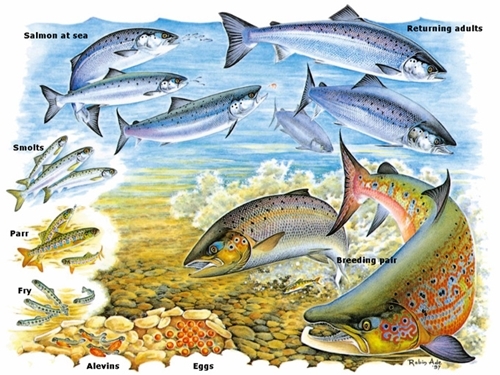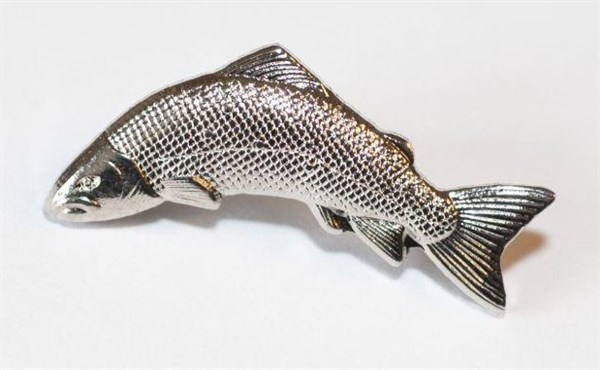Key points
- Atlantic salmon populations have declined recently because they are surviving their time at sea less well.
- It is thought that factors like food availability for young salmon (smolt) in rivers during their freshwater life-phase could affect body size, therefore impacting their subsequent marine survival.
- This study looked at the effect of smolt body size (length) on their return rates from sea to their home river, using data collected during a 12-year project that tagged 3,688 smolts.
- This showed that bigger smolts had better marine survival, meaning that ‘bigger is better’ when it comes to body size.
- In order to improve the marine return rate for Atlantic salmon, restoration efforts should consider freshwater life-stages by increasing habitat cover and food availability in rivers to maximise both the number and size of emigrating smolts.
Background
Atlantic salmon have a complicated life cycle, involving several stages that occur in different habitats. They hatch from eggs in freshwater streams and rivers where they grow and develop. Then they travel downstream to the sea where they go to feed. Finally, they return to their home river to spawn the next generation.

Illustration courtesy of the Atlantic Salmon Trust and Robin Ade.
Female salmon use their tail to dig nests in gravel riverbeds called redds. The eggs are laid in redds in winter and, after three months, these develop into very small salmon called alevin. In the spring, the alevin swim out of the gravel and begin to eat small water-living insects, at which point they are called fry. Fry grow larger and become camouflaged to suit their river environment, when they are called parr. These parr live and grow in the river for between one and four years depending on the river, its temperature and the amount of prey available. Parr then ‘smoltify’ when they are around 14cm long by developing saltwater tolerance. This process involves a change in camouflage to suit the marine environment, as well as changes inside their body that will allow them to cope with saltwater.
The young salmon are now called smolts. They travel downstream to the sea where they will live and grow for up to four years until they are ready to return to the river as adults to spawn. At sea, salmon travel with the ocean currents and eat plankton, small fish and fish fry. Some return to the river where they hatched after only one year at sea, and others stay at sea for a few years before they return to spawn.
It is important to understand the whole salmon life cycle, as conservation can then be targeted at specific stages. This study focused on how freshwater development might affect survival of salmon at sea, specifically whether the body size of smolts affects their survival.
What they did
 Since 2006, salmon smolts in the River Frome in southern England have been monitored when they leave and return to the river. Each autumn during the 12-year study, around 10,000 parr were captured, fitted with a passive integrated transponder (PIT) tag (like a microchip) and returned to the river. Each spring, parr smoltify and migrate to the sea, and some of these smolts were captured again to be measured and weighed. A total of 3,688 smolts were re-measured and released during the study.
Since 2006, salmon smolts in the River Frome in southern England have been monitored when they leave and return to the river. Each autumn during the 12-year study, around 10,000 parr were captured, fitted with a passive integrated transponder (PIT) tag (like a microchip) and returned to the river. Each spring, parr smoltify and migrate to the sea, and some of these smolts were captured again to be measured and weighed. A total of 3,688 smolts were re-measured and released during the study.
After usually one or two years at sea, the adult salmon return to the River Frome. The returning adults were detected using a PIT antenna positioned along the river and categorised as having spent either one winter at sea (1SW) or multiple winters at sea (MSW). 86 of the 3,688 smolts were detected retuning to the river.
The authors built and compared three statistical models that could identify whether a smolt’s length when leaving the river influenced their subsequent survival to return, which represents their survival at sea. The models were able to account for: the time individuals spent at sea; imperfect detection of adults when they returned to the rivers; and loss of data due to monitoring equipment failure.
What they found
The normal range for smolt length in the River Frome was 12-16cm. The statistical models showed that larger smolts within this range had better marine survival. After one winter at sea, 0.95% of smolts that were 12cm long returned to the River Frome, whereas 3.4% of 16cm long smolts returned.
What does this mean?
 Using data collected on thousands of individual smolts over a 12-year period, this study has shown that larger salmon smolts are more than three times more likely to survive their first winter at sea.
Using data collected on thousands of individual smolts over a 12-year period, this study has shown that larger salmon smolts are more than three times more likely to survive their first winter at sea.
There is growing evidence that ‘bigger is better’ when it comes to the size of Atlantic salmon smolts. This might be because larger smolts can escape predators more easily due to their size or stronger swimming abilities. Larger smolts may also be in better physical condition and have higher survival rates in general.
Most importantly, the findings in this study show that factors affecting salmon in their freshwater life stage have a significant impact on their survival later in life. From a conservation perspective, it is easier to make management changes in the rivers compared to the sea. Therefore, habitat cover and food availability in rivers could be managed to nurture larger and better condition salmon smolts.
Read the original paper
Gregory, S.D., Ibbotson, A.T., Riley, W.D., Nevoux, M., Lauridsen, R.B., Russell, I.C., Britton, J.R., Gillingham, P.K., Simmons, O.M., & Rivot, E. (2019). Atlantic salmon return rate increases with smolt length. ICES Journal of Marine Science 76 (6): 1702-1712.

Get your GWCT Fisheries Badge for £9.99
£5 from the sale of each badge goes directly to our fisheries research centre in Dorset
You can help us understand what's driving the decline in Atlantic Salmon numbers by buying one of our salmon pewter pin badges. The badge measures approx. 3cm.
View Badge >
or
Buy Now - £9.99 >
100% Secure. All Credit & Debit cards, PayPal, Apple Pay and Google Pay accepted.
